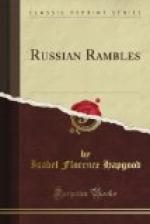Another church service on the following day—a day when public offices are closed and business ceases—completed the religious duties of the festival. In the afternoon, the whole town began to flock to the Imperial Park surrounding the Old Palace,—people of the upper circles included,—the latter from motives of curiosity, of course. Three bands of the Guards furnished the music. On the great terrace, shaded by oak-trees hardly beyond the bronze-pink stage of their leafage, played the hussars. Near the breakfast gallery, with its bronze statues of Hercules and Flora, which the common people call “Adam and Eve” (the Ariadne on Naxos, in a neighboring grotto, is popularly believed to be “a girl of seven years, who was bitten by a snake while roaming the Russian primeval forest, and died"), were the cuirassiers. The stryelki (sharpshooters) were stationed near the lake, the central point for meetings and promenades during the lovely “white nights;” where boats of every sort, from a sail-boat or a Chinese sampan to an Astrakhan fishing-boat or a snowshoe skiff, are furnished gratis all summer, with a sailor of the Guard to row them, if desired. Round and round and round, unweariedly, paced the girls. They were bareheaded and in slippered feet, as usual, but had abandoned the favorite ulster, which too often accompanies extremities thus unclad, to display their gayest gowns. The young men gazed with intense interest. Here and there a young fellow in “European clothes” was to be seen conversing with the more conservative young merchants, who retained the wrinkled boots confining full trousers, the shirt worn outside the trousers, the cloth vest, and the blue cloth long coat of traditional cut.
It was like a scene from the theatre. Across the lake, dotted with boating parties, stretched lawns planted with trees chosen for their variety of foliage, from the silver willow to the darkest evergreens, while the banks were diversified with a boat-house, a terraced grotto, a Turkish kiosk with a bath, bridges, and so on. Of the immense palace which stood so near at hand the graceful breakfast gallery alone was visible, while high above the waving crests of the trees the five cupolas of the palace church, in the shape of imperial crowns, seemed to float in the clear blue sky like golden bubbles. The lawns within the acacia-hedged compartments were dazzling with campanulas, harebells, rose campions, and crimson and yellow columbine, or gleamed with the pale turquoise of forget-me-nots. We had only to enter the adjoining park surrounding the Alexander Palace, built for Alexander I. by his grandmother, Katherine II., to find the Field of the Cloth of Gold realized by acres of tall double Siberian buttercups, as large and as fragrant as yellow roses.




